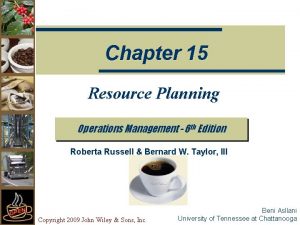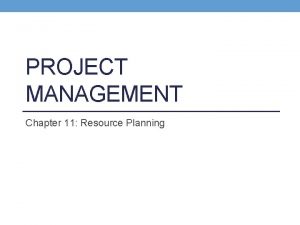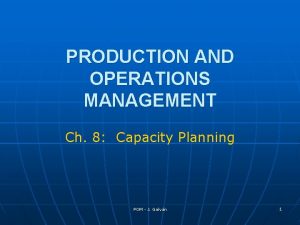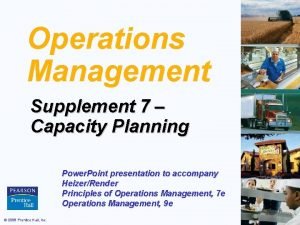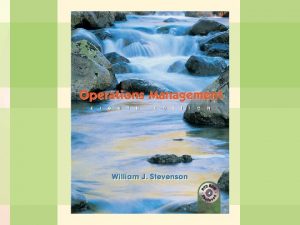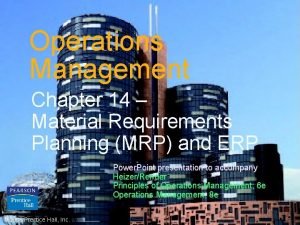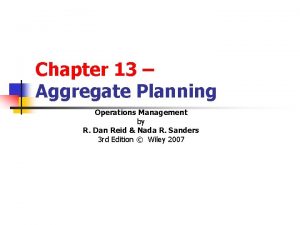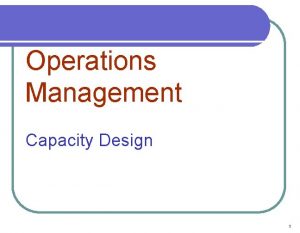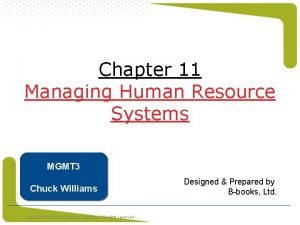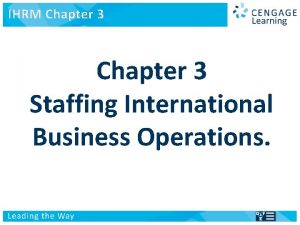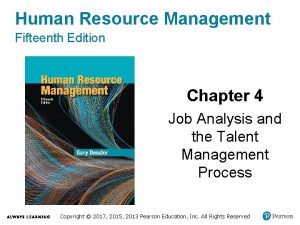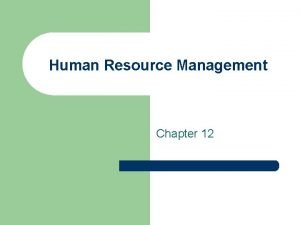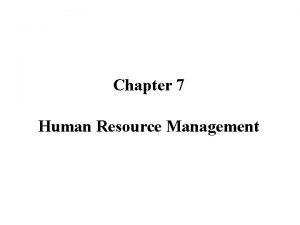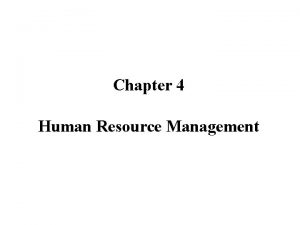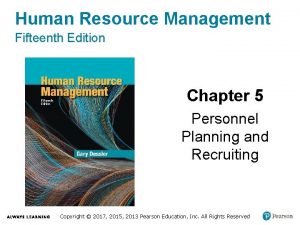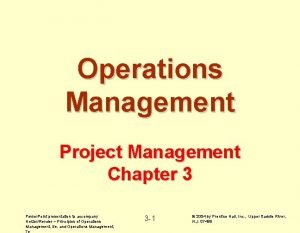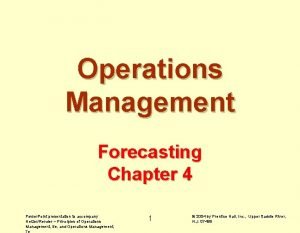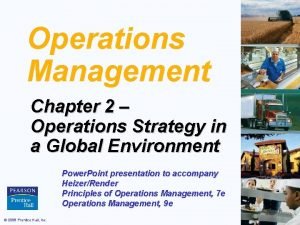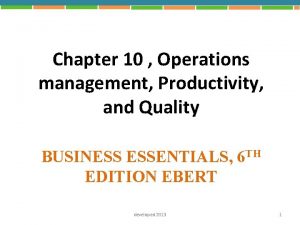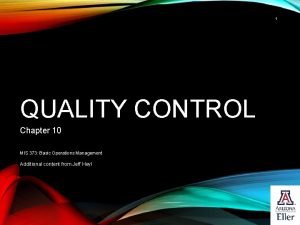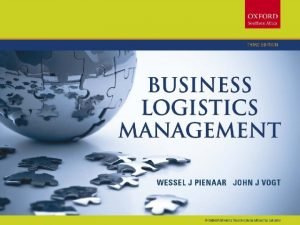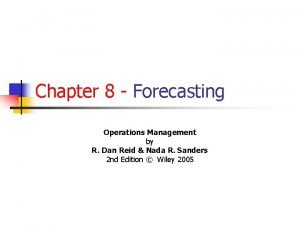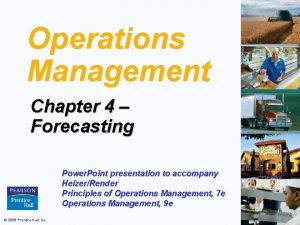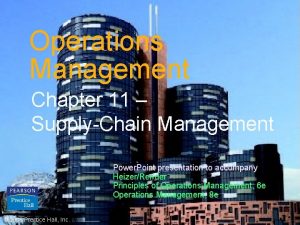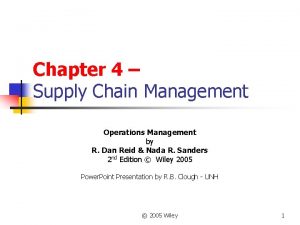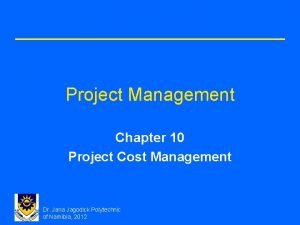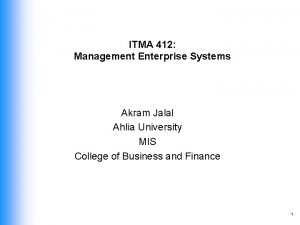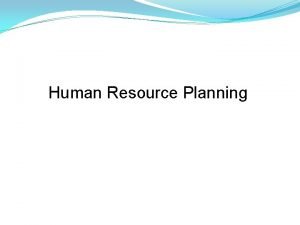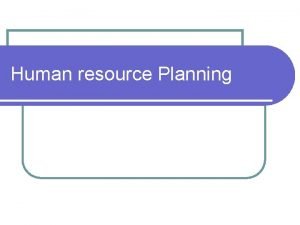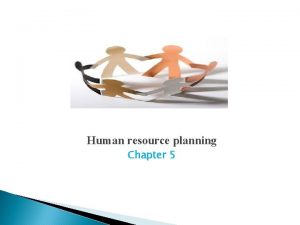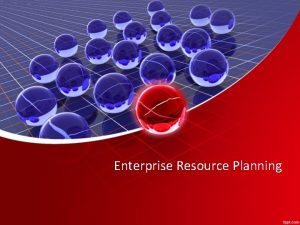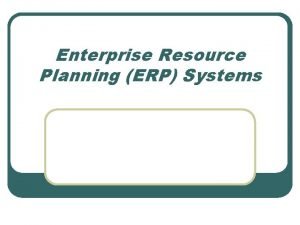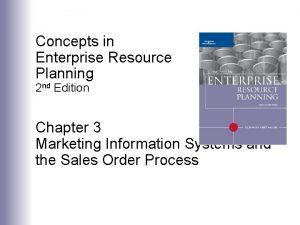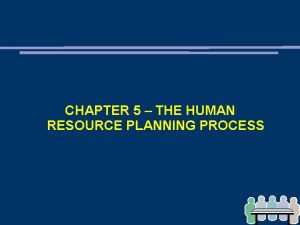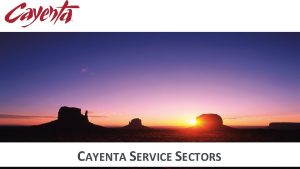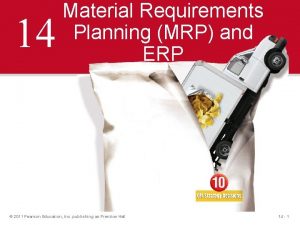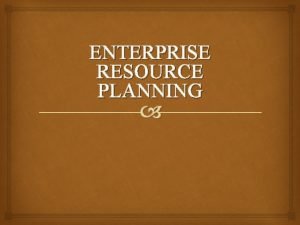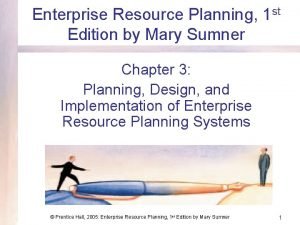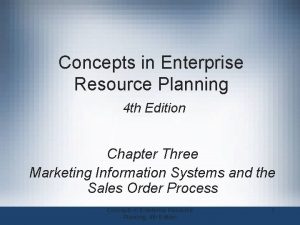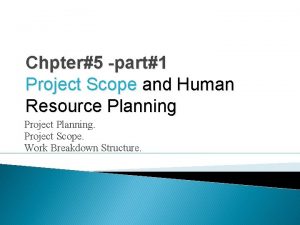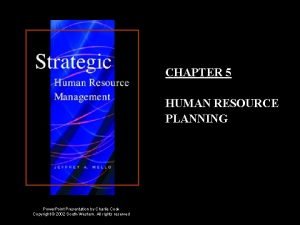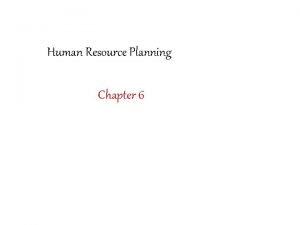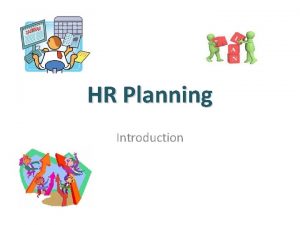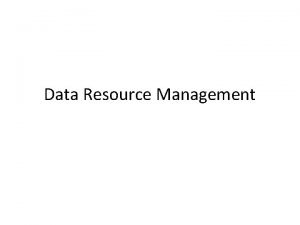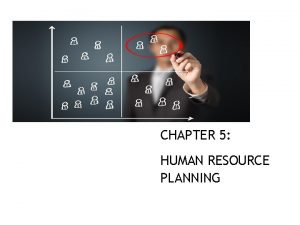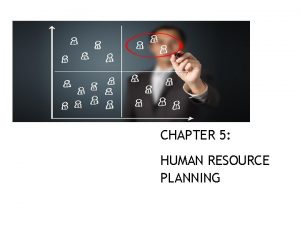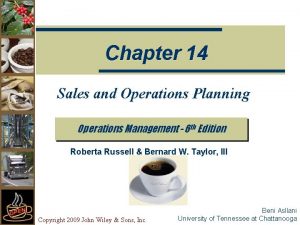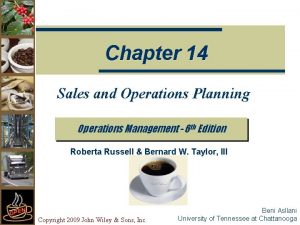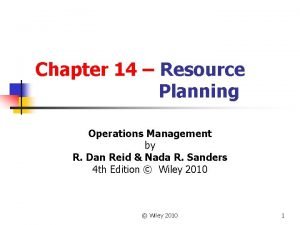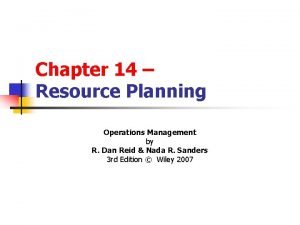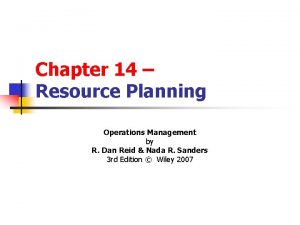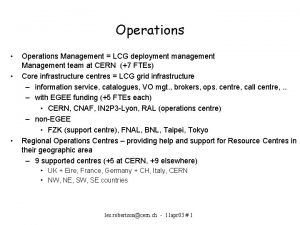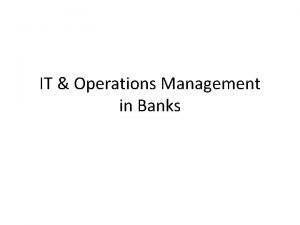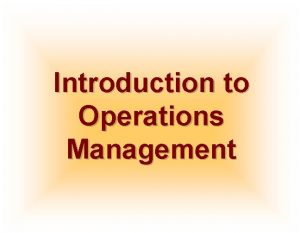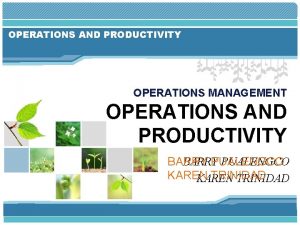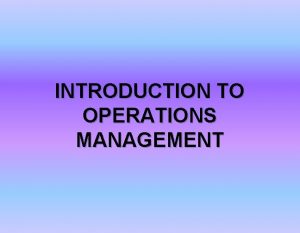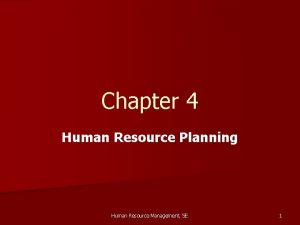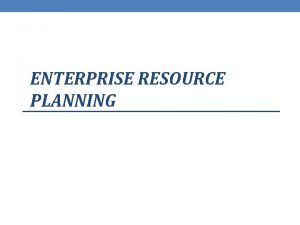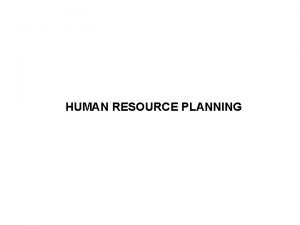Chapter 15 Resource Planning Operations Management 6 th
















































































- Slides: 80

Chapter 15 Resource Planning Operations Management - 6 th Edition Roberta Russell & Bernard W. Taylor, III Copyright 2009 John Wiley & Sons, Inc. Beni Asllani University of Tennessee at Chattanooga

ERP—Enterprise Resource Planning w Starts with slide 56 w We will not be covering the material on pages 647 -667 of Chapter 15 until after the second exam Copyright 2006 John Wiley & Sons, Inc. 14 -2

Lecture Outline w w w Material Requirements Planning (MRP) Capacity Requirements Planning (CRP) Enterprise Resource Planning (ERP) Customer Relationship Management (CRM) Supply Chain Management (SCM) Product Lifecycle Management (PLM) Copyright 2009 John Wiley & Sons, Inc. 15 -3

Resource Planning for Manufacturing Copyright 2009 John Wiley & Sons, Inc. 15 -4

Material Requirements Planning (MRP) w Computerized inventory control and production planning system w When to use MRP? n n n Dependent demand items Discrete demand items Complex products Job shop production Assemble-to-order environments Copyright 2009 John Wiley & Sons, Inc. 15 -5

Demand Characteristics Dependent demand Independent demand 100 x 1 = 100 tabletops 100 x 4 = 400 table legs 100 tables Continuous demand Discrete demand 400 – 300 – No. of tables 400 – 200 – 1 2 3 Week 4 300 – 200 – 100 – 5 Copyright 2009 John Wiley & Sons, Inc. M T W Th F 15 -6

Material Requirements Planning Product structure file Master production schedule Material requirements planning Item master file Planned order releases Work orders Copyright 2009 John Wiley & Sons, Inc. Purchase orders Rescheduling notices 15 -7

MRP Inputs and Outputs w Inputs n n n Master production schedule Product structure file Item master file w Outputs n Planned order releases l l l Copyright 2009 John Wiley & Sons, Inc. Work orders Purchase orders Rescheduling notices 15 -8

Master Production Schedule w Drives MRP process with a schedule of finished products w Quantities represent production not demand w Quantities may consist of a combination of customer orders and demand forecasts w Quantities represent what needs to be produced, not what can be produced w Quantities represent end items that may or may not be finished products Copyright 2009 John Wiley & Sons, Inc. 15 -9

Master Production Schedule (cont. ) MPS ITEM Pencil Case Clipboard Lapdesk 1 125 85 75 0 Copyright 2009 John Wiley & Sons, Inc. PERIOD 2 3 4 125 95 120 50 125 120 47 0 125 100 20 50 5 125 100 17 0 15 -10

Product Structure Clipboard Top clip (1) Bottom clip (1) Pivot (1) Spring (1) Rivets (2) Finished clipboard Pressboard (1) Copyright 2009 John Wiley & Sons, Inc. 15 -11

Product Structure Tree Clipboard Pressboard (1) Top Clip (1) Level 0 Clip Ass’y (1) Bottom Clip (1) Copyright 2009 John Wiley & Sons, Inc. Rivets (2) Pivot (1) Level 1 Spring (1) Level 2 15 -12

Multilevel Indented BOM LEVEL 0 ----1 ----2 ---2 --1 --- ITEM Clipboard Clip Assembly Top Clip Bottom Clip Pivot Spring Rivet Press Board Copyright 2009 John Wiley & Sons, Inc. UNIT OF MEASURE QUANTITY ea ea 1 1 1 2 1 15 -13

Specialized BOMs w Phantom bills n n n Transient subassemblies Never stocked Immediately consumed in next stage w K-bills n n Group small, loose parts under pseudo-item number Reduces paperwork, processing time, and file space Copyright 2009 John Wiley & Sons, Inc. 15 -14

Specialized BOMs (cont. ) w Modular bills n n Product assembled from major subassemblies and customer options Modular bill kept for each major subassembly Simplifies forecasting and planning X 10 automobile example l l 3 x 8 x 4 = 2, 304 configurations 3 + 8 + 4 = 26 modular bills Copyright 2009 John Wiley & Sons, Inc. 15 -15

Modular BOMs X 10 Automobile Engines (1 of 3) Exterior color (1 of 8) Interior (1 of 3) Interior color (1 of 8) Body (1 of 4) 4 -Cylinder (. 40) Bright red (. 10) Leather (. 20) Grey (. 10) Sports coupe (. 20) 6 -Cylinder (. 50) White linen (. 10) Tweed (. 40) Light blue (. 10) Two-door (. 20) 8 -Cylinder (. 10) Sulphur yellow (. 10) Plush (. 40) Rose (. 10) Four-door (. 30) Neon orange (. 10) Off-white (. 20) Station wagon (. 30) Metallic blue (. 10) Cool green (. 10) Emerald green (. 10) Black (. 20) Jet black (. 20) Brown (. 10) Champagne (. 20) B/W checked (. 10) Copyright 2009 John Wiley & Sons, Inc. 15 -16

Time-phased Bills §an assembly chart shown against a time scale Forward scheduling: start at today‘s date and schedule forward to determine the earliest date the job can be finished. If each item takes one period to complete, the clipboards can be finished in three periods Backward scheduling: start at the due date and schedule backwards to determine when to begin work. If an order for clipboards is due by period three, we should start production now Copyright 2009 John Wiley & Sons, Inc. 15 -17

Item Master File DESCRIPTION Item Pressboard Item no. 7341 Item type Purch Product/sales class Comp Value class B Buyer/planner RSR Vendor/drawing 07142 Phantom code N Unit price/cost 1. 25 Pegging Y LLC 1 Copyright 2009 John Wiley & Sons, Inc. INVENTORY POLICY Lead time Annual demand Holding cost Ordering/setup cost Safety stock Reorder point EOQ Minimum order qty Maximum order qty Multiple order qty Policy code 1 5000 1 50 0 39 316 100 500 1 3 15 -18

Item Master File (cont. ) PHYSICAL INVENTORY On hand Location On order Allocated Cycle Last count Difference 150 W 142 100 75 3 9/5 -2 Copyright 2009 John Wiley & Sons, Inc. USAGE/SALES YTD usage/sales MTD usage/sales YTD receipts MTD receipts Last receipt Last issue 1100 75 1200 0 8/25 10/5 CODES Cost acct. Routing Engr 00754 00326 07142 15 -19

MRP Processes w w Exploding the bill of material Netting out inventory Lot sizing Time-phasing requirements w Netting n w Lot sizing n Copyright 2009 John Wiley & Sons, Inc. process of subtracting onhand quantities and scheduled receipts from gross requirements to produce net requirements determining the quantities in which items are usually made or purchased 15 -20

MRP Matrix Copyright 2009 John Wiley & Sons, Inc. 15 -21

MRP: Example Master Production Schedule Clipboard Lapdesk 1 2 3 4 5 85 0 95 60 120 0 100 60 100 0 Item Master File On hand On order (sch receipt) LLC Lot size Lead time CLIPBOARD 25 175 (Period 1) LAPDESK 20 0 PRESSBOARD 150 0 0 L 4 L 1 0 Mult 50 1 1 Min 100 1 Copyright 2009 John Wiley & Sons, Inc. 15 -22

MRP: Example (cont. ) Product Structure Record Clipboard Pressboard (1) Level 0 Clip Ass’y (1) Rivets (2) Level 1 Lapdesk Pressboard (2) Trim (3’) Copyright 2009 John Wiley & Sons, Inc. Level 0 Beanbag (1) Glue (4 oz) Level 1 15 -23

MRP: Example (cont. ) ITEM: CLIPBOARD LLC: 0 LOT SIZE: L 4 L LT: 1 PERIOD 1 2 Gross Requirements 85 95 Scheduled Receipts 175 Projected on Hand 3 4 5 120 100 25 Net Requirements Planned Order Receipts Planned Order Releases Copyright 2009 John Wiley & Sons, Inc. 15 -24

Basic MRP formulas w Net Requirements = Gross Requirements – scheduled receipts – On-hand Inventory(previous period) w Planned Order Receipt = function (Net Requirements, order policy) w Planned Order Release = Planned Order Receipt backed up by the lead time n Planned Order Releasei-LT = Planned Order Receipti Copyright 2006 John Wiley & Sons, Inc. 14 -25

More formulas w On-hand inventoryi = on-hand inventoryi-1 + scheduled receiptsi + Planned Order Receipti – Gross Requirementsi w Gross Requirements for next level down are determined from the Planned Order Releases at the level above Copyright 2006 John Wiley & Sons, Inc. 14 -26

On-hand inventory w Is always the amount of on-hand inventory at the end of the period w All other items (gross req. , net req. , scheduled receipts, planned order receipts) are amounts at the beginning of the period Copyright 2006 John Wiley & Sons, Inc. 14 -27

MRP: Example (cont. ) ITEM: CLIPBOARD LLC: 0 LOT SIZE: L 4 L LT: 1 PERIOD 1 2 Gross Requirements 85 95 Scheduled Receipts 175 Projected on Hand 25 Net Requirements 3 4 5 120 100 115 0 Planned Order Receipts Planned Order Releases (25 + 175) = 200 units available (200 - 85) = 115 on hand at the end of Period 1 Copyright 2009 John Wiley & Sons, Inc. 15 -28

MRP: Example (cont. ) ITEM: CLIPBOARD LLC: 0 LOT SIZE: L 4 L LT: 1 PERIOD 1 2 Gross Requirements 85 95 Scheduled Receipts 175 Projected on Hand 25 Net Requirements 115 20 0 0 3 4 5 120 100 Planned Order Receipts Planned Order Releases 115 units available (115 - 95) = 20 on hand at the end of Period 2 Copyright 2009 John Wiley & Sons, Inc. 15 -29

MRP: Example (cont. ) ITEM: CLIPBOARD LLC: 0 LOT SIZE: L 4 L LT: 1 PERIOD 1 2 Gross Requirements 85 Scheduled Receipts 175 Projected on Hand 25 Net Requirements 3 4 5 95 120 100 115 20 0 100 Planned Order Receipts Planned Order Releases 100 20 units available (20 - 120) = -100 — 100 additional Clipboards are required Order must be placed in Period 2 to be received in Period 3 Copyright 2009 John Wiley & Sons, Inc. 15 -30

MRP: Example (cont. ) ITEM: CLIPBOARD LLC: 0 LOT SIZE: L 4 L LT: 1 PERIOD 1 2 Gross Requirements 85 Scheduled Receipts 175 Projected on Hand 25 Net Requirements 3 4 5 95 120 100 115 20 0 0 100 100 Planned Order Receipts Planned Order Releases 100 Following the same logic Gross Requirements in Periods 4 and 5 develop Net Requirements, Planned Order Receipts, and Planned Order Releases Copyright 2009 John Wiley & Sons, Inc. 15 -31

MRP: Example (cont. ) ITEM: LAPDESK LLC: 0 LOT SIZE: MULT 50 LT: 1 Gross Requirements PERIOD 1 0 2 60 3 0 4 60 5 0 Scheduled Receipts Projected on Hand 20 Net Requirements Planned Order Receipts Planned Order Releases Copyright 2009 John Wiley & Sons, Inc. 15 -32

MRP: Example (cont. ) ITEM: LAPDESK LLC: 0 LOT SIZE: MULT 50 LT: 1 Gross Requirements PERIOD 1 2 3 4 5 0 60 0 20 10 10 0 40 50 50 50 Scheduled Receipts Projected on Hand 20 Net Requirements Planned Order Receipts Planned Order Releases 50 50 Following the same logic, the Lapdesk MRP matrix is completed as shown Copyright 2009 John Wiley & Sons, Inc. 15 -33

MRP: Example (cont. ) ITEM: CLIPBOARD LOT SIZE: L 4 L LLC: 0 LT: 1 1 Planned Order Releases ITEM: LAPDESK LOT SIZE: MULT 50 LLC: 0 LT: 1 Planned Order Releases ITEM: PRESSBOARD LLC: 0 LOT SIZE: MIN 100 LT: 1 Gross Requirements Scheduled Receipts Projected on Hand 150 Net Requirements Planned Order Receipts Planned Order Releases Copyright 2009 John Wiley & Sons, Inc. 1 2 PERIOD 3 4 100 100 2 PERIOD 3 4 5 50 50 1 PERIOD 3 2 5 15 -34

MRP: Example (cont. ) ITEM: CLIPBOARD LOT SIZE: L 4 L LLC: 0 LT: 1 1 Planned Order Releases ITEM: LAPDESK LOT SIZE: MULT 50 LLC: 0 LT: 1 Planned Order Releases ITEM: PRESSBOARD LLC: 0 LOT SIZE: MIN 100 LT: 1 Gross Requirements Scheduled Receipts Projected on Hand 150 Net Requirements Planned Order Receipts Planned Order Releases Copyright 2009 John Wiley & Sons, Inc. 2 PERIOD 3 4 100 100 x 1 2 PERIOD 3 4 5 x 1 1 50 x 2 1 100 5 50 x 2 PERIOD 2 3 4 100 200 100 5 0 15 -35

MRP: Example (cont. ) ITEM: CLIPBOARD LOT SIZE: L 4 L LLC: 0 LT: 1 1 Planned Order Releases ITEM: LAPDESK LOT SIZE: MULT 50 LLC: 0 LT: 1 Planned Order Releases ITEM: PRESSBOARD LLC: 0 LOT SIZE: MIN 100 LT: 1 Gross Requirements Scheduled Receipts Projected on Hand 150 Net Requirements Planned Order Receipts Planned Order Releases Copyright 2009 John Wiley & Sons, Inc. 1 2 PERIOD 3 4 100 100 2 PERIOD 3 4 50 50 1 100 PERIOD 2 3 4 100 200 100 50 50 100 150 150 100 100 5 5 5 0 0 15 -36

MRP: Example (cont. ) Planned Order Report PERIOD ITEM Clipboard Lapdesk Pressboard Copyright 2009 John Wiley & Sons, Inc. 1 50 100 2 3 4 100 50 100 150 5 15 -37

Lot Sizing in MRP Systems w Lot-for-lot ordering policy w Fixed-size lot ordering policy n n n Minimum order quantities Maximum order quantities Multiple order quantities Economic order quantity Periodic order quantity Copyright 2009 John Wiley & Sons, Inc. 15 -38

Using Excel for MRP Calculations Copyright 2009 John Wiley & Sons, Inc. 15 -39

Advanced Lot Sizing Rules: L 4 L Total cost of L 4 L = (4 X $60) + (0 X $1) = $240 Copyright 2009 John Wiley & Sons, Inc. 15 -40

Advanced Lot Sizing Rules: EOQ minimum order quantity Total cost of EOQ = (2 X $60) + [(10 + 50 + 40) X $1)] = $220 Copyright 2009 John Wiley & Sons, Inc. 15 -41

Advanced Lot Sizing Rules: POQ periods worth of requirements Total cost of POQ = (2 X $60) + [(20 + 40) X $1] = $180 Copyright 2009 John Wiley & Sons, Inc. 15 -42

Planned Order Report Item On hand On order Allocated DATE 9 -26 9 -30 10 -01 10 -08 10 -10 10 -15 10 -23 10 -27 #2740 100 200 50 ORDER NO. Date Lead time Lot size Safety stock SCHEDULED GROSS REQS. RECEIPTS AL 4416 AL 4174 GR 6470 SR 7542 CO 4471 GR 6471 GR 6473 Key: AL = allocated CO = customer order PO = purchase order 25 25 50 200 75 50 25 50 PROJECTED ON HAND 50 25 0 - 50 150 75 25 0 - 50 9 - 25 - 05 2 weeks 200 50 ACTION Expedite SR 10 -01 Release PO 10 -13 WO = work order SR = scheduled receipt GR = gross requirement Copyright 2009 John Wiley & Sons, Inc. 15 -43

MRP Action Report Current date 9 -25 -08 ITEM DATE #2740 #3616 #2412 #3427 #2516 #2740 #3666 10 -08 10 -09 10 -10 10 -15 10 -20 10 -27 10 -31 ORDER NO. QTY. 7542 200 7648 100 200 50 Copyright 2009 John Wiley & Sons, Inc. ACTION Expedite Move forward Move backward De-expedite Release SR PO PO PO SR PO WO 10 -01 10 -07 10 -05 10 -25 10 -30 10 -13 10 -24 15 -44

Capacity Requirements Planning (CRP) w Creates a load profile w Identifies under-loads and over-loads w Inputs n n n Planned order releases Routing file Open orders file Copyright 2009 John Wiley & Sons, Inc. 15 -45

CRP MRP planned order releases Routing file Capacity requirements planning Open orders file Load profile for each process Copyright 2009 John Wiley & Sons, Inc. 15 -46

Calculating Capacity w Maximum capability to produce w Rated Capacity n Theoretical output that could be attained if a process were operating at full speed without interruption, exceptions, or downtime w Effective Capacity n Takes into account the efficiency with which a particular product or customer can be processed and the utilization of the scheduled hours or work Effective Daily Capacity = (no. of machines or workers) x (hours per shift) x (no. of shifts) x (utilization) x ( efficiency) Copyright 2009 John Wiley & Sons, Inc. 15 -47

Calculating Capacity (cont. ) w Utilization n Percent of available time spent working w Efficiency n How well a machine or worker performs compared to a standard output level w Load n Standard hours of work assigned to a facility w Load Percent n Ratio of load to capacity Load Percent = load x 100% capacity Copyright 2009 John Wiley & Sons, Inc. 15 -48

Load Profiles w graphical comparison of load versus capacity w Leveling underloaded conditions: n n n Acquire more work Pull work ahead that is scheduled for later time periods Reduce normal capacity Copyright 2009 John Wiley & Sons, Inc. 15 -49

Reducing Over-load Conditions 1. Eliminating unnecessary requirements 2. Rerouting jobs to alternative machines, workers, or work centers 3. Splitting lots between two or more machines 4. Increasing normal capacity 5. Subcontracting 6. Increasing efficiency of the operation 7. Pushing work back to later time periods 8. Revising master schedule Copyright 2009 John Wiley & Sons, Inc. 15 -50

Hours of capacity Initial Load Profile 120 – 110 – 100 – 90 – 80 – 70 – 60 – 50 – 40 – 30 – 20 – 10 – 0– Normal capacity 1 2 3 4 5 6 Time (weeks) Copyright 2009 John Wiley & Sons, Inc. 15 -51

Hours of capacity Adjusted Load Profile 120 – 110 – 100 – 90 – 80 – 70 – 60 – 50 – 40 – 30 – 20 – 10 – 0– Pull ahead Overtime 1 2 Work an extra shift Push back 3 4 Push back Normal capacity 5 6 Time (weeks) w Load leveling n process of balancing underloads and overloads Copyright 2009 John Wiley & Sons, Inc. 15 -52

Determining Loads and Capacities 2 copiers, 2 operators 5 days/wk, 8 hr/day 1/2 hr meals, 1/2 hr maintenance per day Efficiency Utilization Daily capacity = 100% = 7/8 = 87. 5% = 2 machines x 2 shifts x 8 hours/shift x 100% efficiency x 87. 5% utilization = 28 hours or 1, 680 minutes Example 12. 2 Copyright 2006 John Wiley & Sons, Inc. 14 -53

Determining Loads and Capacities JOB NO. OF COPIES SETUP TIME (MIN) RUN TIME (MIN/UNIT) 10 20 30 40 50 500 1, 000 5, 000 10, 000 2, 000 5. 2 10. 6 3. 4 11. 2 15. 3 0. 08 0. 10 0. 12 0. 14 0. 10 TOTAL TIME 5. 2 + (500 x 0. 08) = 10. 6 + (1, 000 x 0. 10) = 3. 4 + (5, 000 x 0. 12) = 11. 2 + (10, 000 x 0. 14) = 15. 3 + (2, 000 x 0. 10) = 45. 2 110. 6 603. 4 1, 411. 2 215. 3 Load percent = 2, 385. 7 / 1, 680 = 1. 42 x 100% = 142% 2385. 7 min Add another shift: Daily capacity = 2 machines x 3 shifts x 8 hours/shift x 100% efficiency x 87. 5% utilization = 42 hours or 2, 520 minutes Revised load percent = 2, 385. 7 / 2, 520 = 0. 9467 x 100% = 94. 67% Example 12. 2 Copyright 2006 John Wiley & Sons, Inc. 14 -54

Relaxing MRP Assumptions w Material is not always the most constraining resource w Lead times can vary w Not every transaction needs to be recorded w Shop floor may require a more sophisticated scheduling system w Scheduling in advance may not be appropriate for on-demand production. Copyright 2009 John Wiley & Sons, Inc. 15 -55

Enterprise Resource Planning (ERP) w Software that organizes and manages a company’s business processes by n n sharing information across functional areas integrating business processes facilitating customer interaction providing benefit to global companies Copyright 2009 John Wiley & Sons, Inc. 15 -56

ERP and MRP w First came MRP around 1970 n n Thanks to George Plossl, Oliver Wight, Joseph Orlicki MRP is Material Requirements Planning w Then came MRP II around 1980 n MRP II is Manufacturing Resource Planning w Then came ERP around 1990 w Today, its ERP II Copyright 2006 John Wiley & Sons, Inc. 14 -57

Evolution of ERP II Copyright 2006 John Wiley & Sons, Inc. 14 -58

A lesson in Information Architecture w First, we need a problem-solving methodology Copyright 2006 John Wiley & Sons, Inc. 14 -59

Goldratt Methodology (Thinking Process) w What to change? ? w What to change to? ? w How to cause the change? ? Copyright 2006 John Wiley & Sons, Inc. 14 -60

WHAT TO CHANGE CIRCA 1993: Problems with the Mainframe Architecture w Poor data visibility w Long lead times on maintenance, modifications to legacy software (36 months) w No GUI interfaces Copyright 2006 John Wiley & Sons, Inc. 14 -61

More problems w New software apps were expensive and time consuming to develop w Mainframes were computational bottlenecks w Desktop PCs sat idle 99% of the time Copyright 2006 John Wiley & Sons, Inc. 14 -62

Components of any Software Application Copyright 2006 John Wiley & Sons, Inc. 14 -63

Components in brief Copyright 2006 John Wiley & Sons, Inc. 14 -64

Mainframe Architecture Copyright 2006 John Wiley & Sons, Inc. 14 -65

Goldratt: We will build a tree w Called a current reality tree w Begin by identifying the UNDESIRABLE EFFECTS the stakeholders are experiencing w The basic tree relationship: w IF {box a}, then {box b}. Copyright 2006 John Wiley & Sons, Inc. 14 -66

Mainframes were computational bottlenecks Centralized MIS shop backlogs were extending out to 36 months Only the centralized MIS shop could do maintenance and new development work Many new applications were being built Each application had to reside entirely on the mainframe Budgets for MIS shops were stretched to their limits Change requests for existing apps were frequent and increasing Competitive and customer environments are changing rapidly Copyright 2006 John Wiley & Sons, Inc. 14 -67

Sales cannot see what is happening in accounts receivable Sales cannot track customer orders through the manufacturing/distribution process Information visibility across the enterprise is impossible Independent data pools are created that cannot be integrated Islands of automation are created End users develop their own independent applications that run on departmental PC’s Centralized mainframes are computing bottlenecks Copyright 2006 John Wiley & Sons, Inc. Centralized MIS shops have lead times of 36 months or longer 14 -68

WHAT TO CHANGE TO: w An architecture in which the data are totally integrated w An architecture in which most of the processing is not done on mainframes w Decentralization of MIS w What architecture was this? ? ? Copyright 2006 John Wiley & Sons, Inc. 14 -69

HOW TO CAUSE THE CHANGE: w ERP implementation w Solves the problems identified above Copyright 2006 John Wiley & Sons, Inc. 14 -70

Organizational Data Flows Source: Adapted from Joseph Brady, Ellen Monk, and Bret Wagner, Concepts in Enterprise Resource Planning (Boston: Course Technology, 2001), pp. 7– 12 Copyright 2009 John Wiley & Sons, Inc. 15 -71

ERP’s Central Database Copyright 2009 John Wiley & Sons, Inc. 15 -72

Selected Enterprise Software Vendors Copyright 2009 John Wiley & Sons, Inc. 15 -73

ERP Implementation w Analyze business processes w Choose modules to implement n n n Which processes have the biggest impact on customer relations? Which process would benefit the most from integration? Which processes should be standardized? w Align level of sophistication w Finalize delivery and access w Link with external partners Copyright 2009 John Wiley & Sons, Inc. 15 -74

Customer Relationship Management (CRM) w Software that n n Plans and executes business processes Involves customer interaction Changes focus from managing products to managing customers Analyzes point-of-sale data for patterns used to predict future behavior Copyright 2009 John Wiley & Sons, Inc. 15 -75

Supply Chain Management w Software that plans and executes business processes related to supply chains w Includes n n n Supply chain planning Supply chain execution Supplier relationship management w Distinctions between ERP and SCM are becoming increasingly blurred Copyright 2009 John Wiley & Sons, Inc. 15 -76

Product Lifecycle Management (PLM) w Software that n n Incorporates new product design and development and product life cycle management Integrates customers and suppliers in the design process though the entire product life cycle Copyright 2009 John Wiley & Sons, Inc. 15 -77

ERP and Software Systems Copyright 2009 John Wiley & Sons, Inc. 15 -78

Connectivity w Application programming interfaces (APIs) n give other programs well-defined ways of speaking to them w Enterprise Application Integration (EAI) solutions w EDI is being replaced by XML, business language of Internet w Service-oriented architecture (SOA) n collection of “services” that communicate with each other within software or between software Copyright 2009 John Wiley & Sons, Inc. 15 -79

Copyright 2009 John Wiley & Sons, Inc. All rights reserved. Reproduction or translation of this work beyond that permitted in section 117 of the 1976 United States Copyright Act without express permission of the copyright owner is unlawful. Request for further information should be addressed to the Permission Department, John Wiley & Sons, Inc. The purchaser may make back-up copies for his/her own use only and not for distribution or resale. The Publisher assumes no responsibility for errors, omissions, or damages caused by the use of these programs or from the use of the information herein. Copyright 2009 John Wiley & Sons, Inc. 15 -80
 Resource planning in operations management
Resource planning in operations management Human resources and job design in operations management
Human resources and job design in operations management Chapter 12 inventory management
Chapter 12 inventory management Resource loading definition
Resource loading definition Resource planning definition in project management
Resource planning definition in project management Planned capacity
Planned capacity Capacity planning in operations management
Capacity planning in operations management Location planning and analysis in operation management
Location planning and analysis in operation management Material requirement planning in operations management
Material requirement planning in operations management Retail strategic planning and operations management
Retail strategic planning and operations management What is aggregate planning in operations management
What is aggregate planning in operations management Location cost volume analysis
Location cost volume analysis Types of capacity planning in operations management
Types of capacity planning in operations management Chapter 5 personnel planning and recruiting
Chapter 5 personnel planning and recruiting Resource leveling is the approach to even out the peaks of
Resource leveling is the approach to even out the peaks of Perbedaan antara resource loading dan resource levelling
Perbedaan antara resource loading dan resource levelling Time management in human resource management
Time management in human resource management Assess human resource requirements of a retail organization
Assess human resource requirements of a retail organization Role of personnel management
Role of personnel management Operations and quality management
Operations and quality management Operations management with total quality management book
Operations management with total quality management book Human resource management chapter 2
Human resource management chapter 2 Chapter 9 human resources management
Chapter 9 human resources management Chapter 11 human resource management
Chapter 11 human resource management Chapter 11 forestry and resource management
Chapter 11 forestry and resource management In the united states, most logging takes place in ________.
In the united states, most logging takes place in ________. Human resource management chapter 1
Human resource management chapter 1 Human resources introduction
Human resources introduction Human resource management 15th edition
Human resource management 15th edition Human resource management lecture chapter 1
Human resource management lecture chapter 1 Determinants of staffing choices
Determinants of staffing choices Chapter 4 job analysis and the talent management process
Chapter 4 job analysis and the talent management process Chapter 12 human resource management
Chapter 12 human resource management Chapter 7 human resource management
Chapter 7 human resource management Chapter 7 human resource management
Chapter 7 human resource management Human resource management chapter 4
Human resource management chapter 4 Human resource management chapter 4
Human resource management chapter 4 Human resource management chapter 5
Human resource management chapter 5 Human resource management chapter 5
Human resource management chapter 5 Chapter 11 human resource management
Chapter 11 human resource management Operations management chapter 3 solutions
Operations management chapter 3 solutions Operations management chapter 4 forecasting solutions
Operations management chapter 4 forecasting solutions International strategy
International strategy Objectives of operations management
Objectives of operations management Chapter 3 operations management
Chapter 3 operations management Operations management chapter 10
Operations management chapter 10 Asq control chart
Asq control chart Chapter 8 operations management
Chapter 8 operations management Operations management chapter 3 forecasting solutions
Operations management chapter 3 forecasting solutions Service process matrix
Service process matrix Associative forecasting example
Associative forecasting example Chapter 11 operations management
Chapter 11 operations management 4 flows of supply chain
4 flows of supply chain Operations management chapter 2
Operations management chapter 2 Managerial judgement workforce planning
Managerial judgement workforce planning Resource and cost planning
Resource and cost planning Enterprise resource planning example
Enterprise resource planning example Short term human resource planning
Short term human resource planning Meaning of manpower planning
Meaning of manpower planning Human resource plan definition
Human resource plan definition Skill inventory in human resource planning
Skill inventory in human resource planning Steps of human resource planning
Steps of human resource planning Human resource management past exam papers
Human resource management past exam papers Factors affecting human resource management
Factors affecting human resource management Enterprise resource planning overview
Enterprise resource planning overview Enterprise resourse planning systems
Enterprise resourse planning systems Enterprise resourse planning
Enterprise resourse planning Supply forecasting techniques in hrp
Supply forecasting techniques in hrp Cayenta enterprise resource planning
Cayenta enterprise resource planning Material requirements planning
Material requirements planning Sistema erp adalah
Sistema erp adalah Human induction meaning
Human induction meaning Swot analysis for human resource department
Swot analysis for human resource department Human resource planning definition
Human resource planning definition Konsep dasar erp
Konsep dasar erp Enterprise resource planning mary sumner
Enterprise resource planning mary sumner Concepts in enterprise resource planning
Concepts in enterprise resource planning Wbs human resource management
Wbs human resource management Human resource planning powerpoint presentation
Human resource planning powerpoint presentation Human resource planning definition
Human resource planning definition Hr planning meaning
Hr planning meaning
